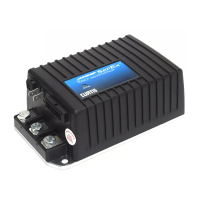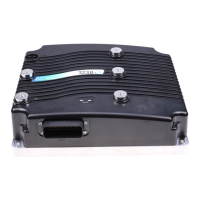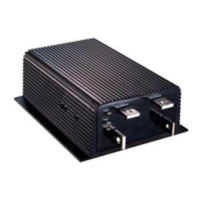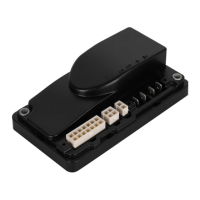Curtis 1230 Manual, Rev. C
49
5 — INITIAL SETUP
4 Initial adjustment of motor control parameters (see pages 36 and 37)
The performance of an AC induction motor is significantly influenced by
temperature. Therefore, the following procedure should be performed with a
warm motor.
4-a. With the interlock switch closed, select a direction and apply throttle.
The motor should begin to turn in the selected direction. If it does not, first
verify the wiring to the throttle and the forward and reverse switches. If the
wiring is correct, turn off the controller, disconnect the battery, and exchange
the motor’s U and V cables on the controller. The motor should now turn in
the proper direction.
CAUTION: The order of the U, V, and W connections
will affect the operation of the emergency reverse feature. The forward and
reverse switches and the motor phase connections must be configured so that
the vehicle drives away from the operator when the emergency reverse button
is pressed.
4-b. Turn on the controller. Stall the motor; you can do this by apply-
ing the brake (by simply unplugging the J2 connector, if your application uses
standard wiring configuration A or B). With the interlock switch closed, select
a direction and apply full throttle for about 3 seconds. Measure the maximum
motor phase current with a suitable RMS current clamp; the clamp must be
accurate at frequencies as low as 5–10 Hz. Note: if you apply the throttle for
a longer time, the anti-stall protection feature will shut down the controller
after about 5 seconds.
4-c. Increase the Accel Slip Voltage parameter, apply throttle, and measure
the max current as in step 4-b. Repeat until the measured current is as desired.
To avoid damage to the motor or to the controller, make sure the maximum
measured motor phase current is not higher than the motor’s maximum current
rating or the controller’s 2-minute rating.
4-d. Set the Regen Slip Voltage parameter to about 20% of the Accel
Slip Voltage parameter value determined in step 4-c. As regenerative current
flows in the opposite direction and causes negative voltage across the internal
resistance, the required voltage to produce the same current as for accelerating
is lower. If the Regen Slip Voltage is set too high, this regenerative behavior
would lead to excessive motor current during braking.
5 Basic vehicle checkout
After completing procedures 1 through 4, use the programmer to check the
wiring. Cycle each switch, observing its status in the Monitor Menu; if your
application has a multiplexer, check the wiring of its switches, also.
Turn on the keyswitch, close the interlock, select a direction, and apply
throttle. The motor should run proportionately faster with increasing throttle.
If it does not, you must find the problem and fix it before continuing; see the
troubleshooting suggestions in Section 7. Do not take the vehicle down off
the blocks until the motor is responding properly.
☞
C A U T I O N
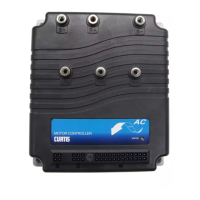
